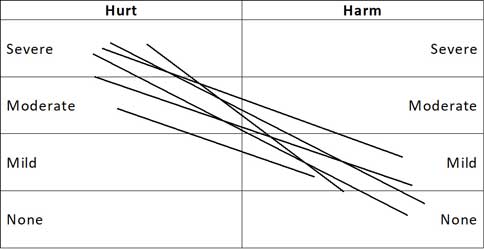Hurt = Harm, or Does It…?
Let’s face it, pain is not a pleasant sensation, but there is a very good reason for this. Pain is your body’s warning system. It tells you that something is wrong or that something is about to go wrong. This is actually a really great system to have; how else would we know if our appendix was about to burst or that we had just stepped on a nail. However, our pain system is not always as accurate or as helpful as this.
I want you to think about the following scenarios before you skim ahead to the answers. Think about how much pain you would experience in that scenario and then think about how much tissue damage actually occurs. Do the two match? You can grade pain and tissue damage as ‘none’, ‘mild’, ‘moderate’ or ‘severe’.
- A headache or migraine
- A paper cut – what happens if you accidentally splash it with lemon juice
- A stubbed toe (not broken)
- An eyelash in your eye
- Stepping on a pin
- Toothache
A headache or migraine – this can be severe pain, however the vast majority of the time there is absolutely no tissue damage occurring.
Papercut – if you run it under water or accidentally squeeze lemon juice over it, this can result in moderate to severe pain, but only very mild tissue damage.
A stubbed toe (not fractured) – a stubbed toe can be extremely painful for a short time; however, it generally results in only mild or no tissue damage.
An eyelash in your eye – this can cause a moderate to severe pain response/irritation in the eye, yet there is no tissue damage.
Stepping on a pin – this can cause moderate pain but only very mild tissue damage.
Toothache – this can sometimes cause severe pain; however, the underlying cause/problem is normally only mild.
Don’t worry if your answers don’t quite match those above, everyone experiences pain differently so there is no right or wrong answer. Now have a look at the accompanying picture. This is a visual representation of what we have just discussed. Can you see that the lines don’t match? Severe pain is often accompanied by mild or no tissue damage. We therefore need to ask how reliable out body’s pain system is? Just because we are experiencing high levels of pain, does not mean we are experiencing high levels of tissue damage – there may actually be no tissue damage going on. Can you think of any other scenarios that follow this pattern?
I will leave you with one final thought. If you suffer from back pain or neck pain (or any injury/pain condition): have you noticed that your pain levels fluctuate throughout the day? You may do an activity and find your pain spikes, then after a short rest they drop back down again. As your pain levels are going up and down through the day is the amount of tissue damage in your body going up and down? The answer is no. Tissue healing takes at least 6 – 8 weeks, it cannot change every half hour. Therefore, as your pain goes up and down through the day, the amount of underlying tissue damage stays the same, regardless of what you are feeling. So pain does not necessarily = tissue damage and the amount of pain does not necessarily correlate with the amount of underlying tissue damage.
The Nebula Physio and Wellbeing Team






